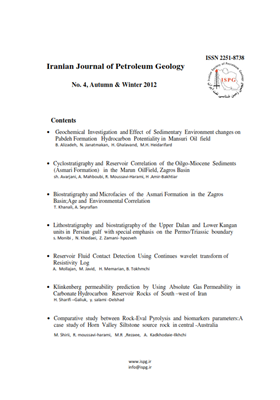-
-
List of Articles
-
Open Access Article
1 - Geochemical Investigation and Effect of Sedimentary Environment Changes on Pabdeh Formation Hydrocarbon Potentiality in Mansuri Oilfield
بهرام علیزاده ندا جنت مکان هرمز قلاوند محمد حسین حیدری فرد -
Open Access Article
2 - Geochemical Investigation and Effect of Sedimentary Environment Changes on Pabdeh Formation Hydrocarbon Potentiality in Mansuri Oilfield
بهرام علیزاده ندا جنت مکان هرمز قلاوند محمد حسین حیدری فرد -
Open Access Article
3 - Cyclostratigraphy and Reservoir Correlation of the Oilgo-Miocene Sediments(Asmari Formation ) in the Marun Oilfield,Zagros Basin
شهرام آورجانی اسداله محبوبی حسن امیری بختیار -
Open Access Article
4 - Biostratigraphy and Microfacies of the Asmari Formation in The Zagros Basin:Age and Environmental Correlation
تهمینه خانعلی -
Open Access Article
5 - Dalan and Lower Kangan units in Persian Gulf with special emphasis on the Permo/ Triassic boundary
سعیده منیبی نواب خدائی زیبا زمانی پژوه -
Open Access Article
6 - Reservoir Fluid Contact Detection Using Continues Wavelet Transform of Resistivity Log
امیر ملا جان مصطفی جاوید حسین معماریان بهزاد تخم چی -
Open Access Article
7 - Klinkenberg Permeability Prediction by Using Absolute Gas Permeability in Carbonate Hydrocarbon Reservoir Rocks of South-West of
حمید شریفی گلویک -
Open Access Article
8 - Comparative study between Rock-Eval pyrolysis and biomarkers parameters: A case study of Horn Valley Siltstone source rock in central- Australia
مهدی شیری سید رضا موسوی حرمی محمد رضا رضائی
-
The rights to this website are owned by the Raimag Press Management System.
Copyright © 2017-2025







